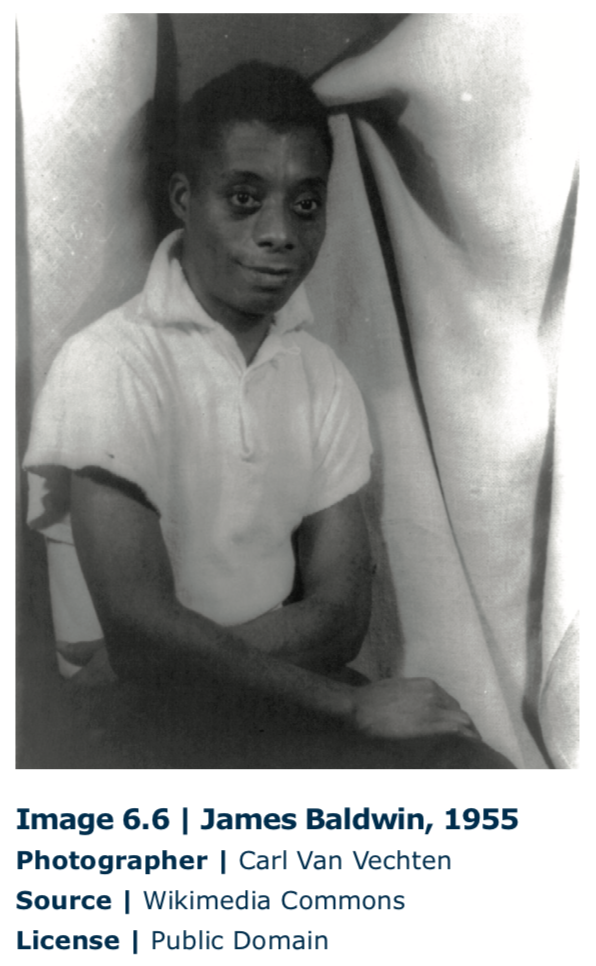6.9: James Baldwin (1924 - 1987)
- Page ID
- 101118
\( \newcommand{\vecs}[1]{\overset { \scriptstyle \rightharpoonup} {\mathbf{#1}} } \)
\( \newcommand{\vecd}[1]{\overset{-\!-\!\rightharpoonup}{\vphantom{a}\smash {#1}}} \)
\( \newcommand{\id}{\mathrm{id}}\) \( \newcommand{\Span}{\mathrm{span}}\)
( \newcommand{\kernel}{\mathrm{null}\,}\) \( \newcommand{\range}{\mathrm{range}\,}\)
\( \newcommand{\RealPart}{\mathrm{Re}}\) \( \newcommand{\ImaginaryPart}{\mathrm{Im}}\)
\( \newcommand{\Argument}{\mathrm{Arg}}\) \( \newcommand{\norm}[1]{\| #1 \|}\)
\( \newcommand{\inner}[2]{\langle #1, #2 \rangle}\)
\( \newcommand{\Span}{\mathrm{span}}\)
\( \newcommand{\id}{\mathrm{id}}\)
\( \newcommand{\Span}{\mathrm{span}}\)
\( \newcommand{\kernel}{\mathrm{null}\,}\)
\( \newcommand{\range}{\mathrm{range}\,}\)
\( \newcommand{\RealPart}{\mathrm{Re}}\)
\( \newcommand{\ImaginaryPart}{\mathrm{Im}}\)
\( \newcommand{\Argument}{\mathrm{Arg}}\)
\( \newcommand{\norm}[1]{\| #1 \|}\)
\( \newcommand{\inner}[2]{\langle #1, #2 \rangle}\)
\( \newcommand{\Span}{\mathrm{span}}\) \( \newcommand{\AA}{\unicode[.8,0]{x212B}}\)
\( \newcommand{\vectorA}[1]{\vec{#1}} % arrow\)
\( \newcommand{\vectorAt}[1]{\vec{\text{#1}}} % arrow\)
\( \newcommand{\vectorB}[1]{\overset { \scriptstyle \rightharpoonup} {\mathbf{#1}} } \)
\( \newcommand{\vectorC}[1]{\textbf{#1}} \)
\( \newcommand{\vectorD}[1]{\overrightarrow{#1}} \)
\( \newcommand{\vectorDt}[1]{\overrightarrow{\text{#1}}} \)
\( \newcommand{\vectE}[1]{\overset{-\!-\!\rightharpoonup}{\vphantom{a}\smash{\mathbf {#1}}}} \)
\( \newcommand{\vecs}[1]{\overset { \scriptstyle \rightharpoonup} {\mathbf{#1}} } \)
\( \newcommand{\vecd}[1]{\overset{-\!-\!\rightharpoonup}{\vphantom{a}\smash {#1}}} \)
\(\newcommand{\avec}{\mathbf a}\) \(\newcommand{\bvec}{\mathbf b}\) \(\newcommand{\cvec}{\mathbf c}\) \(\newcommand{\dvec}{\mathbf d}\) \(\newcommand{\dtil}{\widetilde{\mathbf d}}\) \(\newcommand{\evec}{\mathbf e}\) \(\newcommand{\fvec}{\mathbf f}\) \(\newcommand{\nvec}{\mathbf n}\) \(\newcommand{\pvec}{\mathbf p}\) \(\newcommand{\qvec}{\mathbf q}\) \(\newcommand{\svec}{\mathbf s}\) \(\newcommand{\tvec}{\mathbf t}\) \(\newcommand{\uvec}{\mathbf u}\) \(\newcommand{\vvec}{\mathbf v}\) \(\newcommand{\wvec}{\mathbf w}\) \(\newcommand{\xvec}{\mathbf x}\) \(\newcommand{\yvec}{\mathbf y}\) \(\newcommand{\zvec}{\mathbf z}\) \(\newcommand{\rvec}{\mathbf r}\) \(\newcommand{\mvec}{\mathbf m}\) \(\newcommand{\zerovec}{\mathbf 0}\) \(\newcommand{\onevec}{\mathbf 1}\) \(\newcommand{\real}{\mathbb R}\) \(\newcommand{\twovec}[2]{\left[\begin{array}{r}#1 \\ #2 \end{array}\right]}\) \(\newcommand{\ctwovec}[2]{\left[\begin{array}{c}#1 \\ #2 \end{array}\right]}\) \(\newcommand{\threevec}[3]{\left[\begin{array}{r}#1 \\ #2 \\ #3 \end{array}\right]}\) \(\newcommand{\cthreevec}[3]{\left[\begin{array}{c}#1 \\ #2 \\ #3 \end{array}\right]}\) \(\newcommand{\fourvec}[4]{\left[\begin{array}{r}#1 \\ #2 \\ #3 \\ #4 \end{array}\right]}\) \(\newcommand{\cfourvec}[4]{\left[\begin{array}{c}#1 \\ #2 \\ #3 \\ #4 \end{array}\right]}\) \(\newcommand{\fivevec}[5]{\left[\begin{array}{r}#1 \\ #2 \\ #3 \\ #4 \\ #5 \\ \end{array}\right]}\) \(\newcommand{\cfivevec}[5]{\left[\begin{array}{c}#1 \\ #2 \\ #3 \\ #4 \\ #5 \\ \end{array}\right]}\) \(\newcommand{\mattwo}[4]{\left[\begin{array}{rr}#1 \amp #2 \\ #3 \amp #4 \\ \end{array}\right]}\) \(\newcommand{\laspan}[1]{\text{Span}\{#1\}}\) \(\newcommand{\bcal}{\cal B}\) \(\newcommand{\ccal}{\cal C}\) \(\newcommand{\scal}{\cal S}\) \(\newcommand{\wcal}{\cal W}\) \(\newcommand{\ecal}{\cal E}\) \(\newcommand{\coords}[2]{\left\{#1\right\}_{#2}}\) \(\newcommand{\gray}[1]{\color{gray}{#1}}\) \(\newcommand{\lgray}[1]{\color{lightgray}{#1}}\) \(\newcommand{\rank}{\operatorname{rank}}\) \(\newcommand{\row}{\text{Row}}\) \(\newcommand{\col}{\text{Col}}\) \(\renewcommand{\row}{\text{Row}}\) \(\newcommand{\nul}{\text{Nul}}\) \(\newcommand{\var}{\text{Var}}\) \(\newcommand{\corr}{\text{corr}}\) \(\newcommand{\len}[1]{\left|#1\right|}\) \(\newcommand{\bbar}{\overline{\bvec}}\) \(\newcommand{\bhat}{\widehat{\bvec}}\) \(\newcommand{\bperp}{\bvec^\perp}\) \(\newcommand{\xhat}{\widehat{\xvec}}\) \(\newcommand{\vhat}{\widehat{\vvec}}\) \(\newcommand{\uhat}{\widehat{\uvec}}\) \(\newcommand{\what}{\widehat{\wvec}}\) \(\newcommand{\Sighat}{\widehat{\Sigma}}\) \(\newcommand{\lt}{<}\) \(\newcommand{\gt}{>}\) \(\newcommand{\amp}{&}\) \(\definecolor{fillinmathshade}{gray}{0.9}\)
James Baldwin nació en Harlem, el mayor de nueve hijos. Aunque no conocía a su padre biológico, la difícil relación de Baldwin con su padrastro, un predicador laico que compartía su nombre de James Baldwin, fue una gran influencia tanto en los escritos como en la vida de Baldwin. A los catorce años, un joven Baldwin intentó seguir los pasos de su padrastro como predicador, pero su interés duró poco. En la secundaria, Baldwin se unió a la revista literaria de la escuela y comenzó a hacer viajes a Greenwich Village. Estos viajes sólo despertaron aún más sus intereses en las artes y se hizo amigo de muchos artistas profesionales, entre ellos Beauford Delaney, un pintor afroamericano que encontró fama durante el Renacimiento de Harlem. Como relata en su ensayo, “Notas sobre un hijo nativo”, el padrastro de Baldwin murió en 1943 y fue enterrado en el decimonoveno cumpleaños de Baldwin, que fue, posteriormente, tanto el día en que nació su hermano menor como el día de los disturbios de Harlem.
En 1944, tras la muerte de su padrastro, Baldwin se mudó a Greenwich Village, para centrarse en convertirse en escritor. Fue aquí donde Baldwin encontró una comunidad artística, formando amistades con artistas como Marlon Brando y su héroe literario, Richard Wright. Con la ayuda de Wright, Baldwin recibió la beca Eugene Saxton (1945). Baldwin comenzó a publicar ensayos en revistas influyentes, como The Nation y Partisan Review; sin embargo, en 1948, debido a su desilusión como hombre negro y gay en Estados Unidos, Baldwin siguió el camino de otros expatriados, entre ellos Wright, al mudarse a París. A pesar de que viviría tanto en Suiza como en Turquía, Baldwin finalmente se instaló en Saint-Paul de Vence, al sur de Francia.
La primera novela de Baldwin, Go Tell It on the Mountain (1953), fue un gran éxito crítico y comercial. A pesar de ser ficción, las similitudes biográficas en la novela sobre un joven, John Grimes que cuestiona la hipocresía de la iglesia, su propia educación religiosa, su propia sexualidad y sus frustraciones por ser afroamericano fueron bastante transparentes. En 1955, lanzó su primera colección de ensayos, los influyentes Notas sobre un hijo nativo, pero fue su novela de seguimiento, La habitación de Giovanni (1956), que fue objeto de controversia internacional por su contenido homoerótico. La novela sigue a David quien, después de que su novia lo deja, tiene una aventura con un barman italiano, Giovanni.
El debut del libro de ensayos de Baldwin The Fire Next Time (1963) sólo consolidó aún más su reputación como uno de los escritores estadounidenses más famosos e influyentes del siglo XX. Baldwin, a pesar de vivir en Francia, fue una figura sumamente influyente durante el movimiento estadounidense de Derechos Civiles, alineándose con el Comité Coordinador Estudiantil No Violento (SNCC), realizando varios viajes al sur americano, trabajando con figuras como Martin Luther King Jr. En 1963, apareció en la portada de la revista Time por su trabajo sobre el movimiento Derechos Civiles.
En su famoso cuento, “Sonny's Blues”, Baldwin trata el conflicto entre dos hermanos, uno profesor de matemáticas y el otro, Sonny, un músico recientemente liberado de la cárcel. A lo largo de la historia, queda claro que los dos hermanos no se conocen muy bien y que, aunque los problemas de Sonny son explícitos, los problemas del narrador son más implícitos.
6.10.1 “Sonny's Blues”
Haga clic en el siguiente enlace para acceder a esta selección:
swcta.net/moore/files/2012/02/sonnysblues.pdf
6.10.2 Preguntas de lectura y revisión
- La historia describe una relación tipo Caín y Abel entre el narrador y su hermano. ¿Puedes encontrar alguna otra alusión bíblica en la historia?
- ¿A qué se refiere el título, “Sonny's Blues”? ¿Cómo es Sonny tergiversado por su hermano? ¿Por qué su hermano aparece en el concierto al final de la historia?
- ¿Cuál ves como el tema central de esta historia adicción? ¿Reconciliación? ¿Individualidad?


